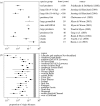Extinction, survival or recovery of large predatory fishes
- PMID: 15713586
- PMCID: PMC1636106
- DOI: 10.1098/rstb.2004.1573
Extinction, survival or recovery of large predatory fishes
Abstract
Large predatory fishes have long played an important role in marine ecosystems and fisheries. Overexploitation, however, is gradually diminishing this role. Recent estimates indicate that exploitation has depleted large predatory fish communities worldwide by at least 90% over the past 50-100 years. We demonstrate that these declines are general, independent of methodology, and even higher for sensitive species such as sharks. We also attempt to predict the future prospects of large predatory fishes. (i) An analysis of maximum reproductive rates predicts the collapse and extinction of sensitive species under current levels of fishing mortality. Sensitive species occur in marine habitats worldwide and have to be considered in most management situations. (ii) We show that to ensure the survival of sensitive species in the northwest Atlantic fishing mortality has to be reduced by 40-80%. (iii) We show that rapid recovery of community biomass and diversity usually occurs when fishing mortality is reduced. However, recovery is more variable for single species, often because of the influence of species interactions. We conclude that management of multi-species fisheries needs to be tailored to the most sensitive, rather than the more robust species. This requires reductions in fishing effort, reduction in bycatch mortality and protection of key areas to initiate recovery of severely depleted communities.
Figures





Similar articles
-
Rapid worldwide depletion of predatory fish communities.Nature. 2003 May 15;423(6937):280-3. doi: 10.1038/nature01610. Nature. 2003. PMID: 12748640
-
Rebuilding global fisheries.Science. 2009 Jul 31;325(5940):578-85. doi: 10.1126/science.1173146. Science. 2009. PMID: 19644114
-
Global trends in world fisheries: impacts on marine ecosystems and food security.Philos Trans R Soc Lond B Biol Sci. 2005 Jan 29;360(1453):5-12. doi: 10.1098/rstb.2004.1574. Philos Trans R Soc Lond B Biol Sci. 2005. PMID: 15713585 Free PMC article. Review.
-
This is more difficult than we thought! The responsibility of scientists, managers and stakeholders to mitigate the unsustainability of marine fisheries.Philos Trans R Soc Lond B Biol Sci. 2005 Jan 29;360(1453):59-75. doi: 10.1098/rstb.2004.1567. Philos Trans R Soc Lond B Biol Sci. 2005. PMID: 15713588 Free PMC article.
-
Towards sustainability in world fisheries.Nature. 2002 Aug 8;418(6898):689-95. doi: 10.1038/nature01017. Nature. 2002. PMID: 12167876 Review.
Cited by
-
Biocomplexity in a highly migratory pelagic marine fish, Atlantic herring.Proc Biol Sci. 2006 Jun 22;273(1593):1459-64. doi: 10.1098/rspb.2005.3463. Proc Biol Sci. 2006. PMID: 16777738 Free PMC article.
-
Food web and fisheries in the future Baltic Sea.Ambio. 2019 Nov;48(11):1337-1349. doi: 10.1007/s13280-019-01229-3. Epub 2019 Jul 26. Ambio. 2019. PMID: 31350721 Free PMC article.
-
Feeding ecology and reproductive biology of small coastal sharks in Malaysian waters.PeerJ. 2023 Aug 21;11:e15849. doi: 10.7717/peerj.15849. eCollection 2023. PeerJ. 2023. PMID: 37637173 Free PMC article.
-
Overfishing and the replacement of demersal finfish by shellfish: an example from the English Channel.PLoS One. 2014 Jul 10;9(7):e101506. doi: 10.1371/journal.pone.0101506. eCollection 2014. PLoS One. 2014. PMID: 25010196 Free PMC article.
-
Towards sustainable fishery management for skates in South America: The genetic population structure of Zearaja chilensis and Dipturus trachyderma (Chondrichthyes, Rajiformes) in the south-east Pacific Ocean.PLoS One. 2017 Feb 16;12(2):e0172255. doi: 10.1371/journal.pone.0172255. eCollection 2017. PLoS One. 2017. PMID: 28207832 Free PMC article.
References
-
- Aldebert Y. Demersal resources of the Gulf of Lions (NW Mediterranean): impact of exploitation on fish diversity. Vie Milieu. 1997;47:275–284.
-
- Alroy J. A multispecies overkill simulation of the end-Pleistocene megafaunal mass extinction. Science. 2001;292:1893–1896. - PubMed
-
- Babcock R.C., Kelly S., Shears N.T., Walker J.W., Willis T.J. Changes in community structure in temperate marine reserves. Mar. Ecol. Prog. Ser. 1999;189:125–134.
-
- Baum J.K., Myers R.A. Shifting baselines and the decline of pelagic sharks in the Gulf of Mexico. Ecol. Lett. 2004;7:135–145.
-
- Baum J.K., Myers R.A., Kehler D., Worm B., Harley S.J., Doherty P.A. Collapse and conservation of shark populations in the northwest Atlantic. Science. 2003;299:389–392. - PubMed
Publication types
MeSH terms
LinkOut - more resources
Full Text Sources
Miscellaneous

